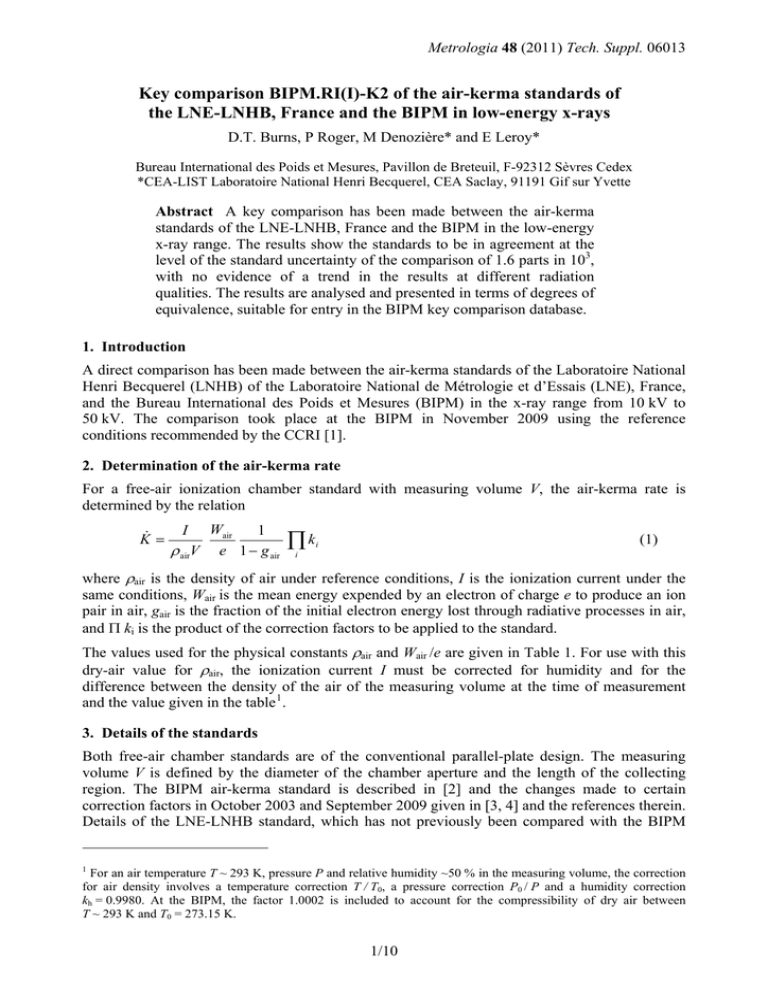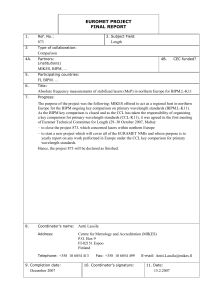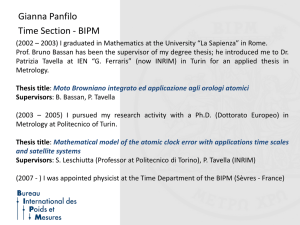Final Report
advertisement

Metrologia 48 (2011) Tech. Suppl. 06013 Key comparison BIPM.RI(I)-K2 of the air-kerma standards of the LNE-LNHB, France and the BIPM in low-energy x-rays D.T. Burns, P Roger, M Denozière* and E Leroy* Bureau International des Poids et Mesures, Pavillon de Breteuil, F-92312 Sèvres Cedex *CEA-LIST Laboratoire National Henri Becquerel, CEA Saclay, 91191 Gif sur Yvette Abstract A key comparison has been made between the air-kerma standards of the LNE-LNHB, France and the BIPM in the low-energy x-ray range. The results show the standards to be in agreement at the level of the standard uncertainty of the comparison of 1.6 parts in 103, with no evidence of a trend in the results at different radiation qualities. The results are analysed and presented in terms of degrees of equivalence, suitable for entry in the BIPM key comparison database. 1. Introduction A direct comparison has been made between the air-kerma standards of the Laboratoire National Henri Becquerel (LNHB) of the Laboratoire National de Métrologie et d’Essais (LNE), France, and the Bureau International des Poids et Mesures (BIPM) in the x-ray range from 10 kV to 50 kV. The comparison took place at the BIPM in November 2009 using the reference conditions recommended by the CCRI [1]. 2. Determination of the air-kerma rate For a free-air ionization chamber standard with measuring volume V, the air-kerma rate is determined by the relation K& = Wair 1 ρ airV e 1 − g air I ∏k (1) i i where ρair is the density of air under reference conditions, I is the ionization current under the same conditions, Wair is the mean energy expended by an electron of charge e to produce an ion pair in air, gair is the fraction of the initial electron energy lost through radiative processes in air, and Π ki is the product of the correction factors to be applied to the standard. The values used for the physical constants ρair and Wair /e are given in Table 1. For use with this dry-air value for ρair, the ionization current I must be corrected for humidity and for the difference between the density of the air of the measuring volume at the time of measurement and the value given in the table 1 . 3. Details of the standards Both free-air chamber standards are of the conventional parallel-plate design. The measuring volume V is defined by the diameter of the chamber aperture and the length of the collecting region. The BIPM air-kerma standard is described in [2] and the changes made to certain correction factors in October 2003 and September 2009 given in [3, 4] and the references therein. Details of the LNE-LNHB standard, which has not previously been compared with the BIPM 1 For an air temperature T ~ 293 K, pressure P and relative humidity ~50 % in the measuring volume, the correction for air density involves a temperature correction T / T0, a pressure correction P0 / P and a humidity correction kh = 0.9980. At the BIPM, the factor 1.0002 is included to account for the compressibility of dry air between T ~ 293 K and T0 = 273.15 K. 1/10 Metrologia 48 (2011) Tech. Suppl. 06013 standard, are given in [5]. The main dimensions, the measuring volume and the polarizing voltage for each standard are shown in Table 2. Table 1. Physical constants used in the determination of the air-kerma rate Value uia ρairb (BIPM) 1.293 0 kg m–3 0.000 1 ρairb (LNE-LNHB) 1.204 8 kg m–3 0.000 1 33.97 J C–1 0.001 5 Constant Wair / e a ui is the relative standard uncertainty. b The value used at the BIPM is for dry air at T0 = 273.15 K and P0 = 101 325 Pa, while at the LNE-LNHB the value is for T0 = 293.15 K and P0 = 101 325 Pa. Table 2. Main characteristics of the standards Standard BIPM LNE-LNHB Aperture diameter / mm 9.941 5.008 5 Air path length / mm 100.0 71.95a Collecting length / mm 15.466 20.445a Electrode separation / mm 70 118.6 Collector width / mm 71 99.5a Measuring volume / mm3 1 200.4 402.80 Polarizing voltage / V +1 500 +3 000 a These are the values for collector 2. 3. Comparison procedure 3.1 The BIPM irradiation facility and reference beam qualities The comparison was carried out in the BIPM low-energy x-ray laboratory, which houses a constant-potential generator and a tungsten-anode x-ray tube with an inherent filtration of 1 mm beryllium. A beryllium filter of thickness 2.16 mm is added (for all radiation qualities) so that the half-value layer (HVL) of the present 10 kV radiation quality matches that of the original BIPM x-ray tube when the same aluminium filter is used. A voltage divider is used to measure the generating potential, which is stabilized using an additional feedback system of the BIPM. Rather than use a transmission monitor, the anode current is measured and the ionization chamber current normalized for any deviation from the reference anode current. The resulting variation in the BIPM free-air chamber current over the duration of a comparison is normally not more than 2 parts in 104 and the standard deviation of repeat air-kerma determinations over the past few years is below 3 parts in 104. The radiation qualities used in the range from 10 kV to 50 kV are those recommended by the CCRI [1] and are given in Table 3 in ascending HVL from left to right. The irradiation area is temperature controlled at around 20 °C and is stable over the duration of a calibration to better than 0.1 °C. Two thermistors, calibrated to a few mK, measure the 2/10 Metrologia 48 (2011) Tech. Suppl. 06013 temperature of the ambient air and the air inside the BIPM standard. Air pressure is measured by means of a calibrated barometer positioned at the height of the beam axis. The relative humidity is controlled within the range from 47 % to 53 %. Table 3. Characteristics of the BIPM reference radiation qualities Radiation quality 10 kV 30 kV 25 kV 50 kVb 50 kVa Generating potential / kV 10 30 25 50 50 Additional Al filtration / mm 0 0.208 2 0.372 3 1.008 2 3.989 Al HVL / mm 0.037 0.169 0.242 1.017 2.262 (µ/ρ)aira / cm2 g–1 14.84 3.661 2.604 0.753 0.378 K& BIPM / mGy s–1 1.00 1.00 1.00 1.00 1.00 a Measured for an air path length of 100 mm using a variable-pressure tube. 3.2 Correction factors The correction factors applied to the ionization current measured at each radiation quality, together with their associated uncertainties, are given in Table 4 for the BIPM standard and in Table 5 for the LNE-LNHB standard. Table 4. Correction factors for the BIPM standard Radiation quality 10 kV 30 kV 25 kV 50 kVb 50 kVa uiA uiB Air attenuation kaa 1.195 7 1.045 1 1.031 9 1.009 1 1.004 6 0.000 2 0.000 1 Scattered radiation kscb 0.9962 0.9972 0.9973 0.9977 0.9979 - 0.000 3 Fluorescence kflb 0.9952 0.9971 0.9969 0.9980 0.9985 - 0.000 5 Electron loss ke 1.000 0 1.000 0 1.000 0 1.000 0 1.000 0 - 0.000 1 Ion recombination ks 1.000 6 1.000 7 1.000 7 1.000 7 1.000 7 0.000 1 0.000 1 Polarity kpol 1.000 5 1.000 5 1.000 5 1.000 5 1.000 5 0.000 1 Field distortion kd 1.000 0 1.000 0 1.000 0 1.000 0 1.000 0 - 0.000 7 Diaphragm effects kdia 0.999 9 0.999 5 0.999 6 0.998 9 0.998 4 - 0.000 3 Wall transmission kp 1.000 0 1.000 0 1.000 0 1.000 0 1.000 0 0.000 1 Humidity kh 0.998 0 0.998 0 0.998 0 0.998 0 0.998 0 - 0.000 3 1 – gair 1.000 0 1.000 0 1.000 0 1.000 0 1.000 0 - 0.000 1 - - a Values for 293.15 K and 101.325 kPa; each measurement is corrected using the air density measured at the time. b Values for ksc and kfl adopted in October 2003, based on Monte Carlo calculations. c Correction factor kdia for diaphragm transmission, scatter and fluorescence adopted September 2009, replacing the factor kl. See reference [6]. 3/10 Metrologia 48 (2011) Tech. Suppl. 06013 The largest correction at low energies is that due to the attenuation of the x-ray fluence along the air path between the reference plane and the centre of the collecting volume. The correction factor ka is evaluated using the measured mass attenuation coefficients (μ/ρ)air given in Table 3. In practice, the values used for ka take account of the temperature and pressure of the air in the standard at the time of the measurements. The value for ka for the LNE-LNHB chamber at 10 kV has been increased by the factor 1.000 9 to account for the larger mean air-attenuation coefficient for an air path length of 72 mm (the values given in Table 3 were measured at the BIPM for an air path length of 100 mm). This effect is negligible at the other radiation qualities. Ionization measurements are also corrected for changes in air attenuation arising from variations in the temperature and pressure of the ambient air between the radiation source and the reference plane. Measurements using the BIPM standard were made using positive polarity only. A correction factor of 1.000 5 was applied to correct for the known polarity effect in the standard. Similarly, measurements using the LNE-LNHB standard were made using positive polarity only and a correction factor of 1.000 0 was applied, based on the results of the additional measurements noted in Section 4.3. All measured ionization currents are corrected for ion recombination. The measured values for the ion recombination correction ks for the BIPM standard are given in Table 4. For the LNELNHB standard, the values for ks given in Table 5 for the BIPM air-kerma rates are derived from the values determined at the LNE-LNHB for the same air-kerma rates. Table 5. Correction factors for the LNE-LNHB standard Radiation quality 10 kV 30 kV 25 kV 50 kVb 50 kVa uiA uiB Air attenuation kaa 1.137 2 1.032 2 1.022 8 1.006 5 1.003 3 0.000 2 0.000 1b Scattered radiation kscc 0.989 0 0.993 8 0.994 0 0.995 7 0.996 2 - 0.000 7 Electron loss ke 1.000 0 1.000 0 1.000 0 1.000 0 1.000 0 - 0.000 1 Ion recombination ks 1.000 7 1.000 7 1.000 7 1.000 7 1.000 7 - 0.000 3 Polarity kpol 1.000 0 1.000 0 1.000 0 1.000 0 1.000 0 0.000 2 Field distortion kd 1.000 0 1.000 0 1.000 0 1.000 0 1.000 0 - 0.000 5 Diaphragm effects kdiad 0.999 9 0.999 1 0.999 1 0.997 5 0.996 8 - 0.000 4 Wall transmission kp 1.000 0 0.999 9 0.999 9 0.999 2 0.999 2 - 0.000 1 Humidity kh 0.998 0 0.998 0 0.998 0 0.998 0 0.998 0 - 0.000 3 1 – gair 1.000 0 1.000 0 1.000 0 1.000 0 1.000 0 - 0.000 1 - a Values for 293.15 K and 101.325 kPa, determined using the BIPM values for the air-attenuation coefficient; each measurement is corrected using the air density measured at the time. b For measurements at the LNE-LNHB, the value is 0.006 0 for the 10 kV quality and 0.001 0 for the others. c This includes the effect of fluorescence, treated separately for the BIPM standard as kfl. d As noted in Section 6, these were calculated by Monte Carlo methods following the comparison measurements. 3.3 Chamber positioning and measurement procedure The LNE-LNHB chamber was positioned close to the BIPM chamber and both remained fixed throughout the comparison; the alternation of measurements between chambers was carried out 4/10 Metrologia 48 (2011) Tech. Suppl. 06013 by displacement of the radiation source. Alignment on the beam axis was measured to around 0.1 mm and this position was reproducible to better than 0.01 mm. No correction is applied for the radial non-uniformity of the beam; for apertures of diameter 5 mm and 10 mm, the nonuniformity correction is the same at the level of 2 parts in 104. The reference plane for each chamber was positioned at 500 mm from the radiation source for all qualities. This distance was measured to 0.03 mm and was reproducible to better than 0.01 mm. The beam diameter in the reference plane is 45 mm for all qualities. The air temperature for the LNE-LNHB chamber was measured using a BIPM mercury thermometer calibrated to better than 0.1 K and positioned in the holder of the chamber. An additional uncertainty component of 3 parts in 104 is included in the ionization current measurement. The leakage current was measured before and after each series of ionization current measurements and a correction made based on the mean of these leakage measurements. For the BIPM chamber the leakage current, relative to the ionization current of 43 pA, was less than 1 part in 104 and for the LNE-LNHB chamber, with measured current 15 pA, less than 2 parts in 104. For the LNE-LNHB chamber, the standard uncertainty of the mean of a series of seven measurements, each with integration time 60 s, was less than 2 parts in 104. Two series were made for each comparison. For the BIPM standard, a similar series was made for each comparison with a standard uncertainty always below 1 part in 104. For each radiation quality (except 25 kV), the comparison was repeated on a subsequent day (the chambers remaining fixed in position) and the two comparison results for each quality agreed to 1 part in 104. 4. Supporting measurements 4.1 Air attenuation The LNE-LNHB standard has three collectors that in principle can be used to determine the airattenuation correction. Measurements with all three collectors were made at 10 kV and at 30 kV. However, the results did not give reasonable values for air attenuation. Moreover, the discrepancies observed were very similar for the two radiation qualities. Subsequent discussion revealed that similar effects were measured at the LNE-LNHB and the chamber has not been used for such measurements. It is thought that the downstream collector 3 has a significant mechanical imperfection while the upstream collector 1 is in a region where the electric field might not be homogeneous. The LNE-LNHB method for determining ka is using a measured x-ray spectrum and calculated attenuation coefficients. This method gives values for ka that differ from the BIPM estimates by 3 parts in 103 for the 30 kV and 25 kV radiation qualities (the larger difference of 5 parts in 103 at 10 kV might be due in part to the lower Al HVL of 0.034 mm at the LNE-LNHB). These differences are under investigation at the LNE-LNHB. 4.2 Lead collimator for LNE-LNHB standard The LNE-LNHB standard has a lead collimator of diameter 10 mm and length 20 mm inserted into the chamber entrance (approximately 5 cm from the diaphragm). Measurements at 50 kVa without this collimator confirmed the LNE-LNHB result that the ionization current increases by 6 parts in 103. This is believed to be due to radiation passing around the outside of the diaphragm support. The lead collimator reduces this effect to 8 parts in 104 (determined at the LNE-LNHB using a lead plug in the aperture) which gives rise to the correction factor kp of Table 5. 4.3 Polarity measurements The polarity correction for the LNE-LNHB standard used on positive polarity was measured for the BIPM 30 kV and 25 kV radiation qualities to be 1.0001(1) and 0.9998(1), respectively. 5/10 Metrologia 48 (2011) Tech. Suppl. 06013 Based on these measurements, a value of unity is used for all radiation qualities with a standard uncertainty of 2 parts in 104 (see Table 5). 5. Uncertainties The uncertainties associated with the primary standards and with the results of the comparison are listed in Table 6. The uncertainties associated with the measurement of the ionization current and with chamber positioning are those which apply to measurements at the BIPM. The combined standard uncertainty uc of the ratio K& LNE -LNHB K& BIPM takes into account correlation in the type B uncertainties associated with the humidity correction and the physical constants. Correlation in the values for ksc, kfl and kdia is taken into account in an approximate way by assuming half of the uncertainty value for each factor at each laboratory. Table 6. Uncertainties associated with the comparison results Standard Relative standard uncertainty BIPM LNE-LNHB uiA uiB uiA uiB Ionization current 0.000 2 0.000 2 0.000 2 0.000 4a Positioning 0.000 1 0.000 1 0.000 1 0.000 1a Volume 0.000 3 0.000 5 - 0.000 8 Correction factors (excl. kh) 0.000 3 0.001 0 0.0003 0.001 0a Humidity kh - 0.000 3 - 0.000 3 Physical constants - 0.001 5 - 0.001 5 0.000 5 0.001 9 0.000 4 0.002 0 K& Standard 0.002 1a 0.002 0 K& LNE-LNHB K& BIPM uc = 0.001 6 b a. For measurements at the LNE-LNHB, the uiB components for ionization current, positioning and correction factors are, respectively, 0.001 2, 0.000 4 and 0.001 4 (0.006 1 at 10 kV). Consequently, the uncertainty of the air-kerma determination at the LNE-LNHB is 0.002 6 (0.006 5 at 10 kV), rather than the value 0.002 1 tabulated here. It is the higher value that appears as uLab i in the KCDB. b. Takes account of correlation in the type B uncertainties. 6. Results and discussion The comparison results are given in Table 7. Agreement at the level of 1 part in 103 is observed, which is well within the standard uncertainty of the comparison of 1.6 parts in 103 given in Table 6. Initially, there was evidence of a trend in the results for the different radiation qualities. It was postulated that this might be due to the fact that a diaphragm correction factor, kdia, is applied to the BIPM standard (Table 4), based on the calculations described in [6], but no corresponding correction was applied at that time to the LNE-LNHB standard. Subsequently, Monte Carlo calculations were made at the LNE-LNHB, resulting in the correction factors kdia given in Table 5. The effect of this new correction is to reduce the trend observed in the initial 6/10 Metrologia 48 (2011) Tech. Suppl. 06013 results to a negligible level. A description of the LNE-LNHB calculations for kdia will be published at a later date. Table 7. Comparison results Radiation quality 10 kV 30 kV 25 kV 50 kVb 50 kVa K& LNE -LNHB K& BIPM 0.999 2 1.000 2 1.000 7 1.000 1 1.000 7 7. Degrees of Equivalence The analysis of the results of BIPM comparisons in low-energy x-rays in terms of degrees of equivalence is described in [7]. Following a decision of the CCRI, the BIPM determination of the air-kerma rate is taken as the key comparison reference value, for each of the CCRI radiation qualities. It follows that for each laboratory i having a BIPM comparison result xi with combined standard uncertainty ui, the degree of equivalence with respect to the reference value is the relative difference Di = (Ki – KBIPM,i) / KBIPM,i = xi – 1 and its expanded uncertainty Ui = 2 ui. The results for Di and Ui, expressed in mGy/Gy and including those of the present comparison, are shown in Table 8 and in Figure 1. Note that these data, while correct at the time of publication of the present report, become out of date as laboratories make new comparisons with the BIPM. The formal results under the CIPM MRA are those available in the BIPM key comparison database. 8. Conclusions The key comparison BIPM.RI(I)-K2 for the determination of air kerma in low-energy x-rays shows the standards of the LNE-LNHB and the BIPM to be in agreement at the level of the standard uncertainty for the comparison of 1.6 parts in 103. A table and graph of degrees of equivalence, including those for the LNE-LNHB, are presented for entry in the BIPM key comparison database. 7/10 Metrologia 48 (2011) Tech. Suppl. 06013 8/10 Metrologia 48 (2011) Tech. Suppl. 06013 25 20 15 5 0 -5 -10 Figure 1. Degrees of equivalence for each NMI i with respect to the key comparison reference value 9/10 ENEA LNE-LNHB ARPANSA MKEH BEV PTB VNIIM METAS NIST NPL -25 VSL -20 NRC -15 NMIJ 10 kV 30 kV 25 kV 50 kVb 50 kVa GUM Di / (mGy/Gy) 10 Metrologia 48 (2011) Tech. Suppl. 06013 References [1] BIPM 1972 Qualités de rayonnement Com. Cons. Etalons Mes. Ray. Ionisants (Section I) 2 R15 [2] BOUTILLON M., HENRY W.H., LAMPERTI P.J. 1969 Comparison of exposure standards in the 10-50 kV x-ray region Metrologia 5 1-11 [3] BURNS D.T. 2004 Changes to the BIPM primary air-kerma standards for x-rays Metrologia 41, L3 [4] BURNS D.T., KESSLER C., ALLISY P.J. 2009 Re-evaluation of the BIPM international standards for air kerma in x-rays Metrologia 46 L21 [5] LEROY E., KSOURI W. 2008 Caractéristiques de la chambre à parois d'air de référence pour les rayons X compris entre 10 et 60 kV Note technique LNHB 08/08 [6] BURNS D.T., KESSLER C 2009 Diaphragm correction factors for free-air chamber standards for air-kerma in x-rays Phys. Med. Biol. 54 2737–45 [7] BURNS D.T. 2003 Degrees of equivalence for the key comparison BIPM.RI(I)-K2 between national primary standards for low-energy x-rays Metrologia 40 Technical Supplement 06031 10/10



